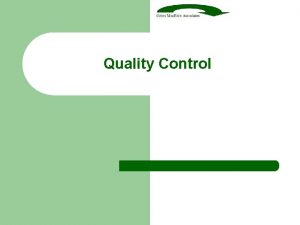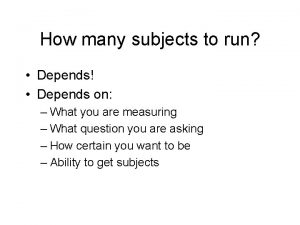Quality control depends on runs processing How the






- Slides: 6

Quality control : depends on runs processing ● How the surveillance of the ECAL is performed at LHC ● Requirements on the System ● Scalability Laser Monitoring 13/02/2006 - 14/02/2006

Activity: CMS-ECAL surveillance nothing to do with physics events processing Quality control: Following the ECAL behavior in real-time Monitoring Tasks: performed during data taking ● Short term correction coefficients ● Electronics calibration ● Detector check ● Supervision of the monitoring system Types of events needed: ● MATACQ events ● Laser events (Blue and Infrared) ● Pedestal events ● PN diodes test pulse events ● APD test pulse events Laser Monitoring 13/02/2006 - 14/02/2006

Full scan of ECAL performed with the events needed for the monitoring tasks Monitoring sequence Time to perform a monitoring sequence: ● 30 minutes at low luminosity ● 20 minutes at high luminosity After each sequence, all the information is available to perform the quality control of the ECAL. After each wavelength and TP on a SM, enough information is available to perform the quality control of the SM and the Laser source. Laser Monitoring 13/02/2006 - 14/02/2006

Defines a system which perform the Quality control: 1) Build the history of the ECAL (Follows up the behavior of ECAL) 2) Detect the Events occurring in ECAL 3) Execute identification, validation and correction procedures 4) Conditional data treatment 5) GUI ● Results of the Quality Control of ECAL at the end of each monitoring sequence ● Provide warning and alarm messages send as soon as possible to shift crews This system process events in quasi real time: ● Data treatment is sequential ● Computation of parameters is iterative Powerful and efficient surveillance system Laser Monitoring 13/02/2006 - 14/02/2006

Processing laser runs must be rather fast 40 seconds: the time needed to have the result of the APD, PN, APD/PN 0, APD/PN 1 responses to blue laser of a full SM. Time dominated by I/O: ● Read the configuration files ● Read data file ● Write reduced data 5 minutes: the time needed to perform the Quality Control of one SM ● Computation of all Pulse Shape parameters for 2 wavelengths ● Computation of APD, PN, APD/PN 0, APD/PN 1 and APD/[½(PN 0+PN 1)] responses to Laser at 2 wavelengths ● Computation TP responses for APDs and PNs These times are measured on a public PC with a benchmark ROOT = 150 Laser Monitoring 13/02/2006 - 14/02/2006

In the real world: ● 36 SMs in the Barrel ● Monitoring sequence takes 30 minutes The defined system must be scalable We must follow the ECAL behavior in quasi real time 3 -4 minutes is the time we kept to perform the Quality Control of one SM The monitoring farm must be composed by 12 PCs at least A Master PC located in the counting room Laser Monitoring 13/02/2006 - 14/02/2006











